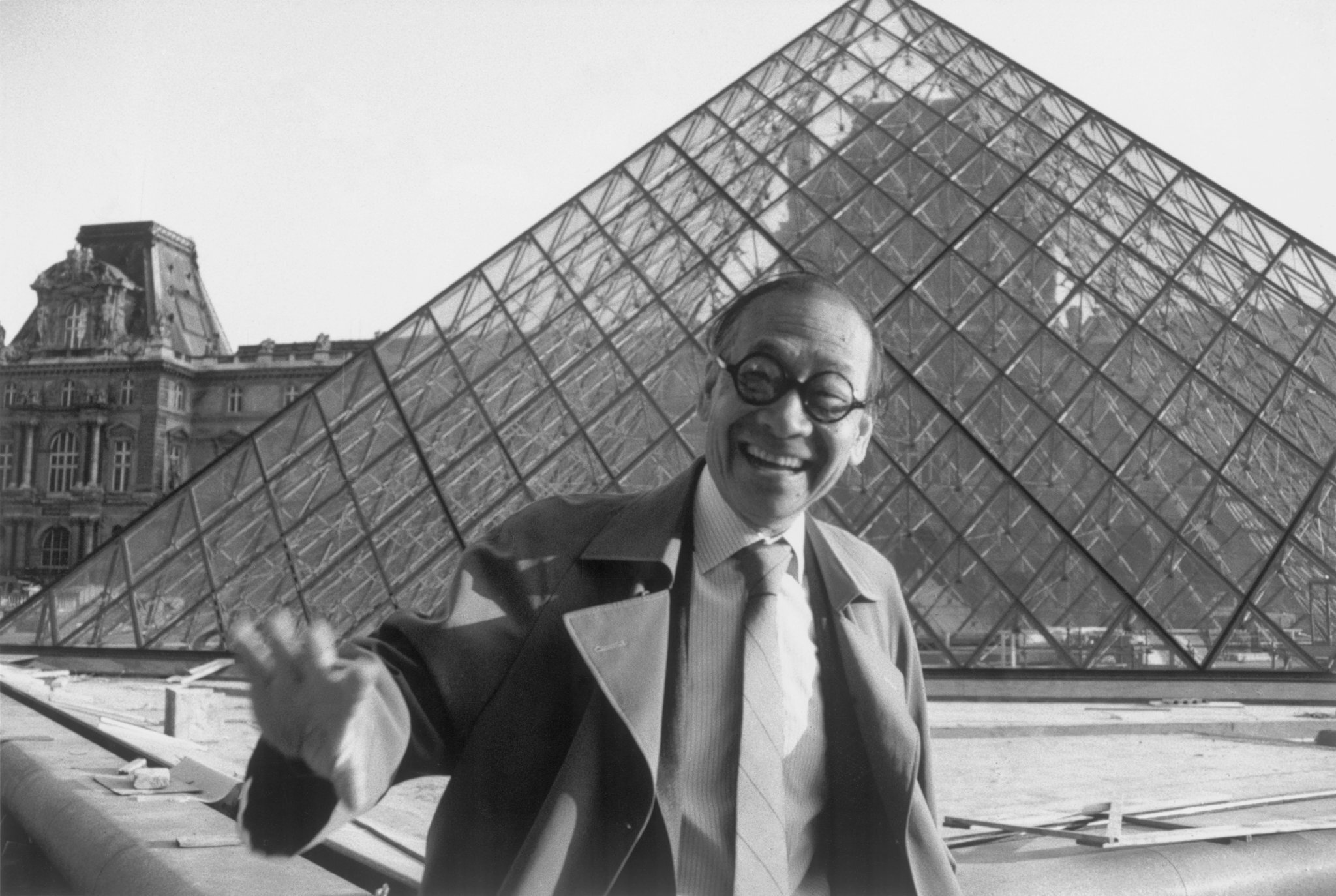Celebrating I.M. Pei & 6 of His Most Significant Projects
The world-renowned Chinese-American architect Ieoh Ming Pei, known as I. M. Pei, passed away yesterday at the age of 102. The acclaimed architect is known for his bold designs and explicit geometries in his projects, spanning his career over six decades.
The Louvre Pyramid in Paris, the Bank of China Tower in Hong Kong, and the East Building of the National Gallery of Art in Washington, D.C. are probably the most well-known projects in Pei's project portfolio. However, Pei's projects, including arts facilities, university buildings, libraries, and civic centers, are more diverse rather than the most well-known projects.
In a jury citation for the Pritzker Prize in 1983, it was stated that "Ieoh Ming Pei’s architecture can be characterized by its faith in modernism, humanized by its subtlety, lyricism, and beauty."
Pei was born in Canton China in 1917 and came to the United States in 1935 to study first at the University of Pennsylvania and then at the Massachusetts Institute of Technology (B. Arch. 1940) and the Harvard Graduate School of Design (M. Arch. 1946).
Rock and Roll Hall of Fame
Cleveland, USA, 1995
Located in Cleveland, Ohio, Pei's design embodies the music celebrated within, the building is an icon of the city that coined the term "rock and roll".
Considered a controversial choice as the building’s architect, Pei, by his own admission, was not very familiar with rock and roll music.
Nonetheless, his design can be seen as symbolizing the dominant musical style of the second half of the twentieth century. Of the building’s design, Pei said, “it was my intention to echo the energy of rock and roll. I have consciously used an architectural vocabulary that is bold and new, and I hope the building will become a dramatic landmark for the city of Cleveland and for fans of rock and roll around the world.”
At the time of the building’s construction, Pei was already a global architectural figure, best known for his pyramid addition to the Louvre Museum in Paris. The bold geometric forms and minimalist beauty of the Rock and Roll Hall of Fame and Museum echo his work at the Louvre.
The architect juxtaposed simple geometric forms to combine diverse functions within a unified whole: a theater cantilevered over Lake Erie one one side balances a circular performance drum on the other, while a 165-foot-high orthogonal tower rises from the water to engage a tetrahedral tower tent.
Pei's building acts like an explosive musical chord, the sculptural components reverberate out from the center. Set back in 1.2-acre performance plaza on the roof of the main exhibition space, the building rises with eight unique floor plates of decreasing size, culminating in the Hall of Fame, contemplative fiber optics chamber.
Le Grand Louvre
Paris, France, 1989
In 1981, the newly elected French president, Francois Mitterrand, launched a campaign to renovate cultural institutions throughout France. One of the most advantageous of those projects was the renovation and reorganization of the Louvre.
In 1983 after touring Europe and the United States, President Mitterrand commissioned the Chinese American architect, I.M. Pei. It was the first time that a foreign architect was enlisted to work on the Louvre museum.
A centrally located glass pyramid forms the main entrance and provides direct access to galleries in each of the museum's three wings. The pyramid's distinctly modern articulation complements the historic Louvre in a dialogue of harmonious contrast.
The expansion and modernization of the historic Louvre was probably one of the most iconic buildings of I.M. Pei. The challenge was to modernize and expand the building and better integrate it with the city, all without compromising the integrity of historic structure.
Completed in 1989, I.M. Pei’s renovation redesigned Cour Napoleon, the main court of the Louvre, in order to alleviate the congestion from the thousands of daily visitors. A new grand entrance provided a convenient, central lobby space separate from the galleries, which provided focal point for the cyclical process of one’s experience through the museum.
In addition to providing a new entrance to the Louvre, Pei’s design featured a new underground system of galleries, storage, and preservation laboratories, as well as a connection between the wings of the museum. The addition and relocation of the supporting spaces of the museum allowed for the Louvre to expand its collection and place more work on exhibit.
Miho Museum
Kyoto, Japan, 1997
The Miho Museum was a joint Japanese and American project completed by architect I. M. Pei and Kibowkan International, Inc. in August of 1996 on a scenic mountainside in a nature preserve near the town of Shigaraki, Shiga prefecture, Japan.
Mihoko Koyama and her daughter, Hiroko Koyama, commissioned the architect I. M. Pei to design the Miho Museum. I. M. Pei's design, which he came to call Shangri-La, is executed in a hilly and forested landscape.
Approximately three-quarters of the 17,400 square meter building is situated underground, carved out of a rocky mountaintop.
The roof is a large glass and steel construction, while the exterior and interior walls and floor are made of a warm beige-colored limestone from France – the same material used by Pei in the reception hall of the Louvre. The structural engineer for this project was Leslie E. Robertson Associates.
Pei continued to make changes to the design of the galleries during construction as new pieces were acquired for the collection.
Pei had earlier designed the bell tower at Misono, the international headquarters and spiritual center of the Shumei organization. The bell tower can be seen from the windows of the museum.
The Miho Museum is situated in the natural rich mountains of Shigaraki, Japan. Pei's concept is based on the Taoyuan Township, which is a destination town drawn by the Chinese poet 'Peach Flower Geno', is guided by the tree-lined path of the weeping cherry blossoms, beyond the tunnel and the suspension bridge to the art museum.
As visitors travel through the beautiful arcing tunnel, they see an entrance with a grommet-shaped roof on the other side of the bridge over the valley. When visitors step into the calm entrance, they are surrounded by the light that is falling from the glass roof and the gentle beige limestone wall, and a large space with a row of gentle mountains will extend to the far side.
Suzhou Museum
Suzhou, China, 2006
As one of the latest built works of acclaimed Pritzker architect I.M. Pei, Suzhou Museum was built in the heart of his hometown, Suzhou, China.
As one of the last surviving modernists, the architect strove to bring together both his modernist sensibilities as well as the Suzhou vernacular.
Sited on the northeast section of the historic quarter of Suzhou, the museum is adjacent to the landmarked Zhong Wang Fu, a complex of 19th-century historical residences.
While the museum carries over many of the geometric and visual elements that characterize Pei’s design – squares, rectangles, and pyramids – the design takes cues from traditional Suzhou architecture with its use of whitewashed plaster walls, dark gray clay tile roofs and intricate garden architecture.
The undulating folds of geometries, coupled with a palette familiar to the Suzhou region, becomes a unique hybrid that represents the architect’s ambition to re-envision the Suzhou and Chinese vernacular in a contemporary context.
Founded in 1960 and originally located in the national historic landmark, Zhong Wang Fu palace complex, Suzhou Museum has been a highly-regarded regional museum with a number of significant Chinese cultural relics.
A new museum designed by world famous architect I.M.Pei was completed in October 2006, covering over 10,700 square meter and located at the cross of Dongbei Street and Qimen Road. The design of this new museum visually complements the traditional architecture of Zhong Wang Fu.
Bank of China Tower
Hong Kong, China, 1990
When commissioned to design the Bank of China Tower on an intricate inland site, I.M. Pei was requested to create an unavoidably tall unique headquarters in a typhoon-prone region that would represent the aspirations of the Chinese people yet also symbolize goodwill toward the British Colony.
The solution assimilates architecture and engineering simultaneously, involving an asymmetrical tower that informs both skyline and street. The Bank of China Tower stands 70 stories tall, reaching a height of 1,209 feet. At the time of its opening in May 1990, it was the tallest building in Asia and still remains one of the tallest in Hong Kong.
Comprised of four vertical shafts, the tower emerges from a 52-meter cube and reduces its mass, quadrant by quadrant, until a single triangular prism resides. The faceted prism is clad in reflective glass that mirrors the changing sky, anchoring the expansive business district and providing a characteristic vertical axis to Hong Kong's towering skyline.
Completed in 1990, Pei's tower represents the successful integration of structure and form to meet the needs of both client and city. With a limited budget and a difficult inland site, the owner requested a distinctive regional headquarters with an imposing banking hall and 130,000-square-metre of office space.
Pei designed a tall and dynamic structure that responds to that criteria. The tower would take advantage of the surrounding views while being robust enough to withstand a typhoon.
John F. Kennedy Presidential Library and Museum
Boston, USA, 1979
After a nine year process and fourteen possible architects the John F. Kennedy Presidential Library was finally finished and dedicated on October 20, 1979. Architect I.M. Pei’s signature geometric shapes of concrete steel and glass created an appropriate stately monumentality.
A juxtaposition of spaces and light quality along with a defined and lucid circulation creates a logical story line of its namesake.
The main body of the structure consists of a singular and brilliant triangular tower protruding from an expanding base of geometric forms. A cube of glass and steel rises along with the tower; hollowed and hallowed it represents reflection on void.
A circulatory system leads the viewer through a relatively dense memorial and archive of the life and political career of the late president. This constrained experience is followed by a dark yet still relatively confined space of the theater where the occupant is shown a brief biographical film. From these tight spaces a new form emerges at the end of the defined path.
A large, aerated, open cube volume allows for a period of reflectance. The visceral connection with the outside world and the home state which President Kennedy dedicated his political life to is tangible through a simplified glass and steel curtain.
Pei was commissioned to design the John F. Kennedy Presidential Library and Museum to the memory of the United States' 35th president. Located on a 10-acre park, overlooking the sea that he loved and the city that launched him to greatness, the Library stands as a vibrant tribute to the life and times of John F. Kennedy.
Designed as a timeless piece, the building is overlooking Boston, and the ocean and beyond, the former landfill site was planted with beach grass to recall Kennedy's love of the sea. A split-level design organizes museum spaces in a layer below ground, with key emotive elements dramatically isolated above.

















